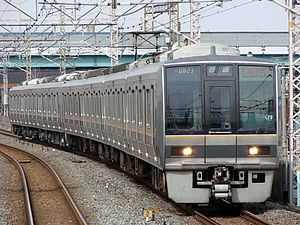Other name(s) Gakkentoshi Line Type Heavy rail Opened 1895 | Native name 片町線 System Urban Network Stations 24 | |
 | ||
Rolling stock 207 series EMU321 series EMU | ||
32 jrwest katamachi line rapid kyobashi kizu
The Katamachi Line (片町線, Katamachi-sen), officially nicknamed the Gakkentoshi Line (学研都市線, Gakkentoshi-sen), is a commuter rail line and service in the Osaka-Kobe-Kyoto Metropolitan Area of Japan, owned and operated by West Japan Railway Company (JR West). The line connects Kizu Station in Kyoto Prefecture and Kyōbashi Station in Osaka.
Contents
- 32 jrwest katamachi line rapid kyobashi kizu
- Basic data
- Route and operation
- Rolling stock
- Former
- History
- Military use
- References
The common name "Gakkentoshi Line", literally "Research City Line", comes from the Kansai Science City, which is located along the line around the border of Osaka and Nara prefectures.
Basic data
Route and operation
The line is connected via the JR Tōzai Line in downtown Osaka, at Amagasaki, to the Tōkaidō Main Line (JR Kobe Line) and Fukuchiyama Line (JR Takarazuka Line). This link enables trains operated from Nara to the west, as Kobe, Himeji, and Sanda.
Rapid services of several types of stops, with no surcharge, are also provided. Abbreviations are tentative for this article.
Rolling stock
All trains are based at Aboshi Depot.
Former
History
The line was originally built and operated by the Naniwa Railway (浪速鉄道, Naniwa Tetsudō) between Katamachi and Shijōnawate in 1895. Two years later, the Kansai Railway bought the line in order to have its own trunk line to Osaka from Nagoya, combined with constructing the section between Shijōnawate and Kizu. Katamachi station was unable to be expanded, thus Amijima terminus was constructed. However Kansai Railway bought the Osaka Railway (I, ja) line from Nara via Ōji to Minatomachi (present JR Namba) in downtown Osaka, and shifted its main line to the ex-Naniwa Railway line. Thereafter, the Katamachi line became a branch of the railway network of Osaka.
The Shigino to Hanaten section was duplicated in 1927, with the Katamachi to Shigino section double-tracked in 1955, the Hanaten to Shijonawate section in 1969, extended to Nagao in 1979, to Matsuiyamate in 1989, and the balance of the section to Kyobashi double-tracked between 2007 and 2009.
The section between Katamachi and Shijōnawate became the first Japan Governmental Railways electrified line in Osaka-Kobe-Kyoto area in 1932, with electrification extended to Nagao in 1950. After privatization of the then Japanese National Railways (JNR), the line became part of the West Japan Railway Company (JR West) system, and the Kizu to Nagao section was electrified in 1989.
In 1997, the JR Tōzai Line was opened and connected to Katamachi Line at Kyōbashi, and Katamachi Station was closed (with Ōsakajō-kitazume Station becoming the replacement station). Most trains began operating through to the Fukuchiyama Line (JR Takarazuka Line).
Converted from a freight branch to a passenger route, the Osaka Higashi Line began service in 2008. Trains from Nara via Kansai Main (Yamatoji) Line are operated to Amagasaki Station.
Military use
Three military/weapons-related facilities used during the early 20th century were serviced by spurs located between Fujisaka and Tsuda Stations (Kin-ya Ammunition Dump, where two explosions occurred in 1909 and 1939), between Kawachi-Iwafune and Hoshida Stations (Uji Weapon Kori Factory), and the Osaka Army Arsenal warehouse between Hanaten and Shigino Stations.
